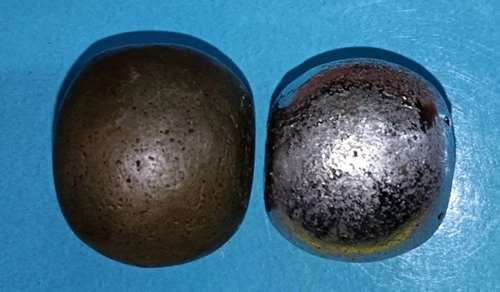Rasamani, also known as Parad Gutika, is a solidified mercury bead revered in traditional Indian alchemy and spirituality. Crafted through intricate processes involving purification and solidification of mercury, Rasamani is esteemed for its purported spiritual and health benefits. However, the market is rife with counterfeit versions that lack the genuine properties of authentic Rasamani. To ensure you possess an original Rasamani, consider the following comprehensive guidelines:
1. Understand the Characteristics of Authentic Rasamani

- Composition: Authentic Rasamani is created by purifying mercury and combining it with specific herbs and minerals, resulting in a solidified bead. This process, rooted in ancient Siddha alchemy, transforms the liquid metal into a stable, solid form.
- Physical Properties: Genuine Rasamani typically measures between 1 to 1.5 inches in diameter and weighs approximately 12 to 30 grams. It possesses a smooth, metallic luster and is cool to the touch.
2. Conduct Physical Tests to Verify Authenticity
- Heat Test: Gently heat the Rasamani. Authentic Rasamani should withstand moderate heat without melting or vaporizing. If the bead vaporizes or shows signs of melting, it may be counterfeit, possibly made from mercury amalgamated with other metals like silver nitrate.
- Milk Test: Place the Rasamani in a small quantity of cow’s milk. Authentic Rasamani is believed to have the property of turning milk into curd within a few minutes. If this transformation does not occur, the Rasamani may not be genuine.
- Aluminum Test: Rub the Rasamani against a piece of aluminum. If black ash appears on the aluminum, it indicates the presence of genuine Rasamani. This reaction is due to the interaction between the mercury content in Rasamani and aluminum.
3. Assess the Source and Craftsmanship
- Reputable Sources: Acquire Rasamani from trusted and reputable sources, such as established spiritual centers or practitioners known for their expertise in traditional alchemy. Authentic Rasamani is often handcrafted by skilled artisans following traditional methods.
- Craftsmanship Quality: Examine the bead for signs of superior craftsmanship. Authentic Rasamani should exhibit a uniform shape, smooth surface, and a consistent metallic sheen. Imperfections or irregularities may indicate a counterfeit product.
4. Be Cautious of Common Adulterants
- Mercury Amalgams: Some counterfeit Rasamani are made by amalgamating mercury with other metals, resulting in beads that may vaporize when heated or lack the beneficial properties of genuine Rasamani. Awareness of such practices can aid in identifying fakes.
5. Consult with Experts
- Seek Guidance: If uncertain about the authenticity of a Rasamani, consult with experts in the field of traditional Indian alchemy or experienced spiritual practitioners. Their insights can provide valuable guidance in verifying authenticity.
6. Reflect on the Intended Use
- Spiritual Significance: Authentic Rasamani is often associated with spiritual practices, including meditation and rituals aimed at enhancing spiritual energy. Understanding its intended use can provide context for its authenticity and significance.
By following these guidelines, you can enhance your ability to identify authentic Rasamani, ensuring that you benefit from its traditional properties and avoid counterfeit products that may lack efficacy or pose health risks.

